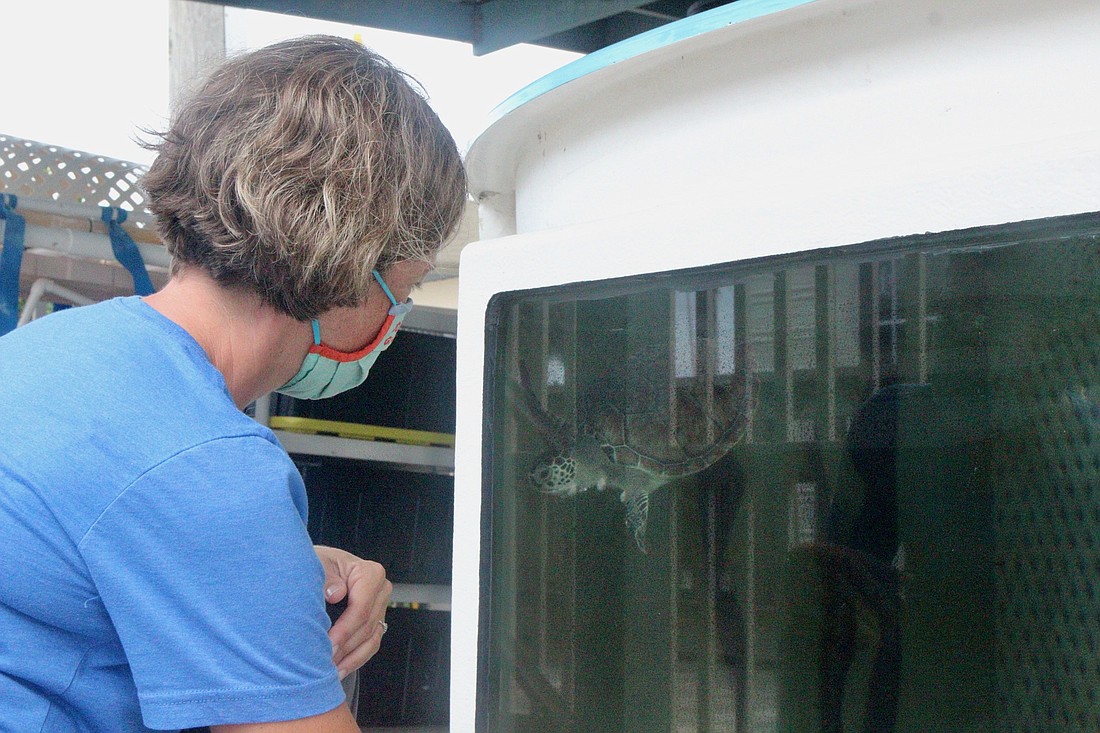- April 20, 2024
-
-
Loading

Loading

A woman in blue scrubs slipped a bag-valve mask over patient Leanne’s nose after her surgery and gave her a few slow breaths — one ... two ... three — while a colleague held the patient behind her flipper.
“Since they’re reptiles, they need a little encouragement to breathe,” said Catherine Eastman, the sea turtle program manager at the Sea Turtle Hospital at the University of Florida’s Whitney Laboratory for Marine Bioscience.
Leanne, a green sea turtle, is the latest patient at the Sea Turtle Hospital to undergo surgery to remove tumors caused by an illness called Fibropapillomatosis. The illness, which the hospital specializes in treating and studying, leaves lesions on the flippers, necks and faces of sea turtles in Florida and elsewhere.
A fundraising event on Oct. 27 brought in $8,350 for the hospital from Coastal Cloud, the Hammock Beach Resort and other sponsors — money that will help pay for the turtles’ food and for the veterinarians and vet techs that treat them.
“We are so lucky to have this amazing research facility in our community ... and the Sea Turtle Hospital is just one piece of that,” Sara Hale, who co-founded and manages Coastal Cloud with her husband Tim Hale, said on WNZF Radio’s “Free For All Friday” program on Oct. 30. “We’ve been happy to help the raise their membership and get donations and volunteers in any way that we can there. But everyone should know that the hospital does need donations and sponsorships to help keep it running, so anyone who also loves sea turtles and wants to help should reach out and help this amazing hospital that we have right here in our community.”
Meanwhile, the lab has raised $14.5 million for a new lab building and is hoping the state will match it.
“We have professors getting these really hard-to-get grants, and they expect your facility to be at a certain level,” said Jessica Long, the Whitney Lab’s senior director of advancement.
THE ILLNESS
Fibropapillomatosis, or FP, was part of the impetus for the creation of the Sea Turtle Hospital, which had its fifth anniversary in October.
“It was a disease we weren’t used to seeing in this part of the state,” said Eastman.
Eastman has been working with sea turtles since the 1990s, when she began doing nesting surveys as a student at Florida Atlantic University.
“They’re almost the canary in the coal mine — they demonstrate the health of the ecosystem,” she said.
The hospital’s 36th patient this year, named Richard, was released on Nov. 4. The hospital usually has about 45 long-term patients per year.
In Florida, FP was first noticed in turtles around the Keys, then became prevalent in the Indian River Lagoon in the 1990s. There’s a virus involved, but it’s not clear how it’s transmitted from turtle to turtle, and the few hardy critters that eat sea turtles don’t seem to contract it.
FP can be debilitating: One turtle at the hospital, named Victor Frankenstein (the hospital has started naming its turtles after famous scientists, including fictional ones), had lesions around both eyes, impairing vision.
Others have flipper lesions that impede swimming or leave the turtle prone to tangling in fishing gear. The hospital has had to amputate flippers for that reason.
Staff try to strike a balance between science and conservation. Sea turtles’ endangered status means that experimentation that might answer some of the open questions about FP must go through a permitting process.
THE PATIENTS
The typical turtle patient stays 6 to 9 months at the hospital before release, spending most of its time outside the operating room in one of a handful of large white tanks onsite.
Staff and volunteers feed them a daily diet of seafood, greens and vitamins. (The older green sea turtles are exclusively vegetarian.)
Some young turtles are puppy-like in their curiosity about the people who dole out their meals, while others fear people and their unfamiliar surroundings, swimming their tanks frantically and prompting staff and volunteers to construct turtle hides out of plastic and PVC.
“If they freak out, we try a little shelter,” Eastman said.
Staff made imitation kelp out of the sliced-up strips of tough, cloth-like material used to clean cars in mechanical car washes, tying the material to bases of PVC.
Most of the seven turtles in the tanks on Nov. 10 were young — about 5-7 years.
“As they age and they get older, they become more and more wild,” Eastman said. The hospital recently released an older patient, she added, “And that animal didn’t want anything to do with us.”
The hospital also tends to washbacks, newly hatched sea turtles that have been pushed back to shore by a storm.
It’s not clear how much of a threat FP poses at the population level. Hospital staff are grateful for being able to save the patients they can.
“Is it enough to say it helps the population?” Eastman said. “No, but every little bit helps.”